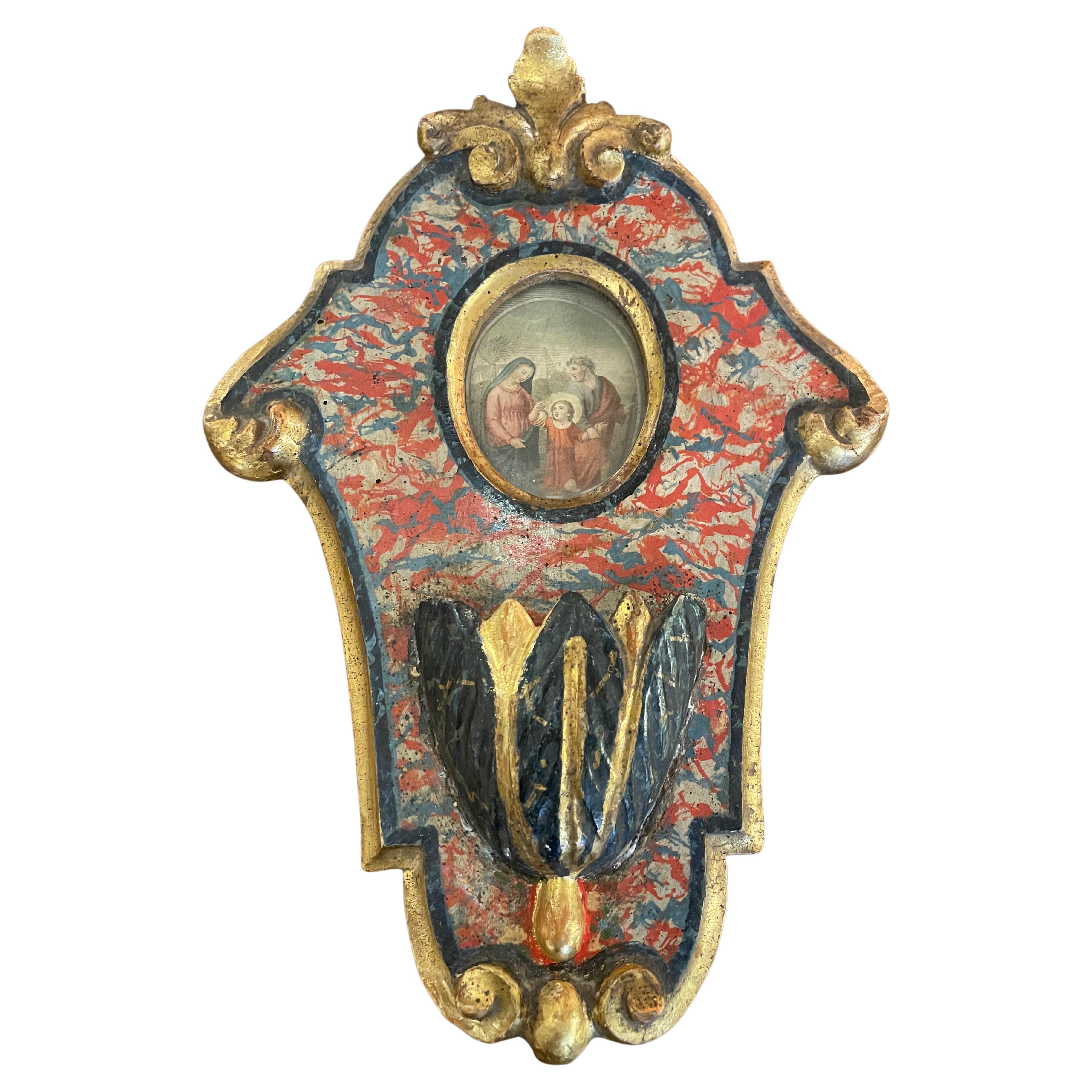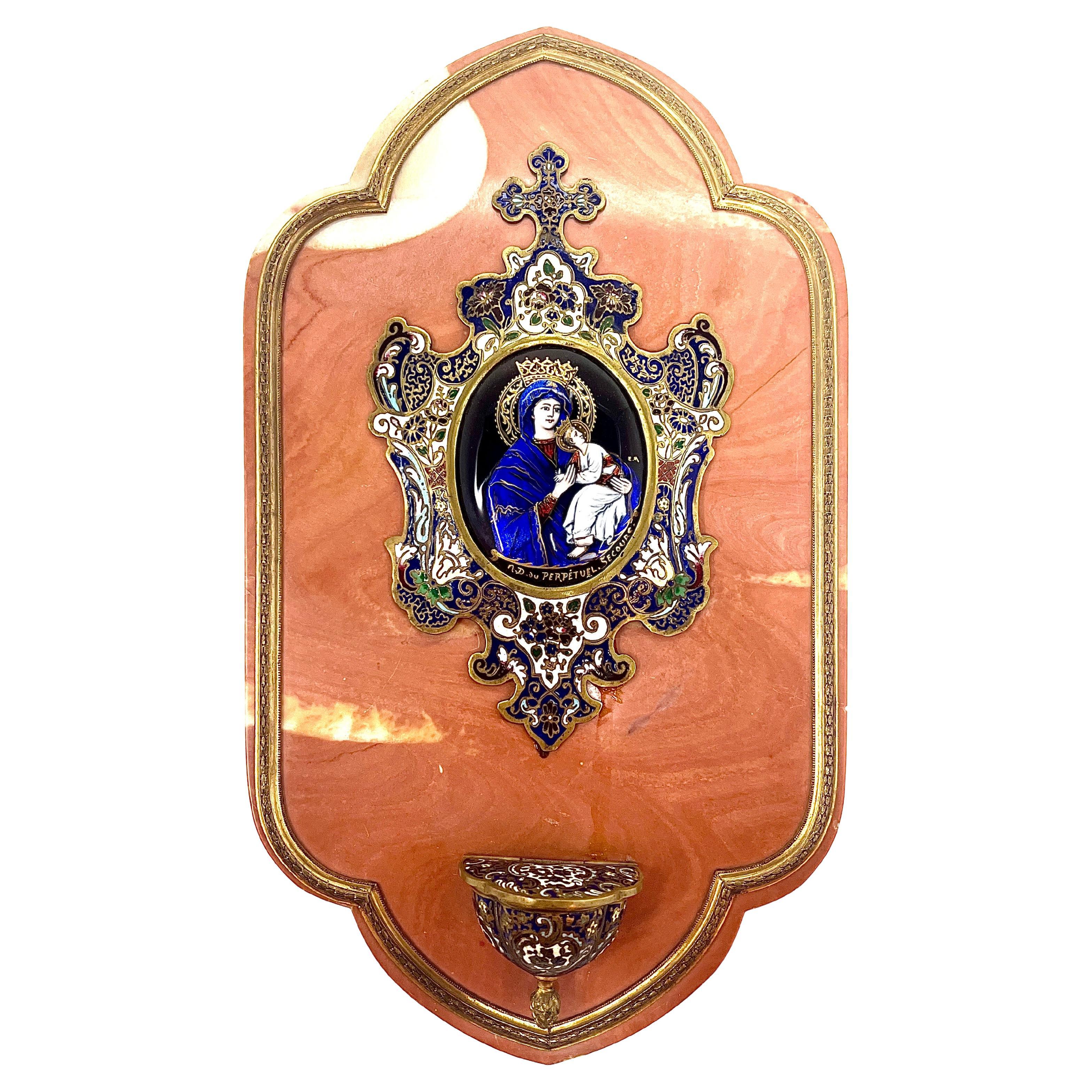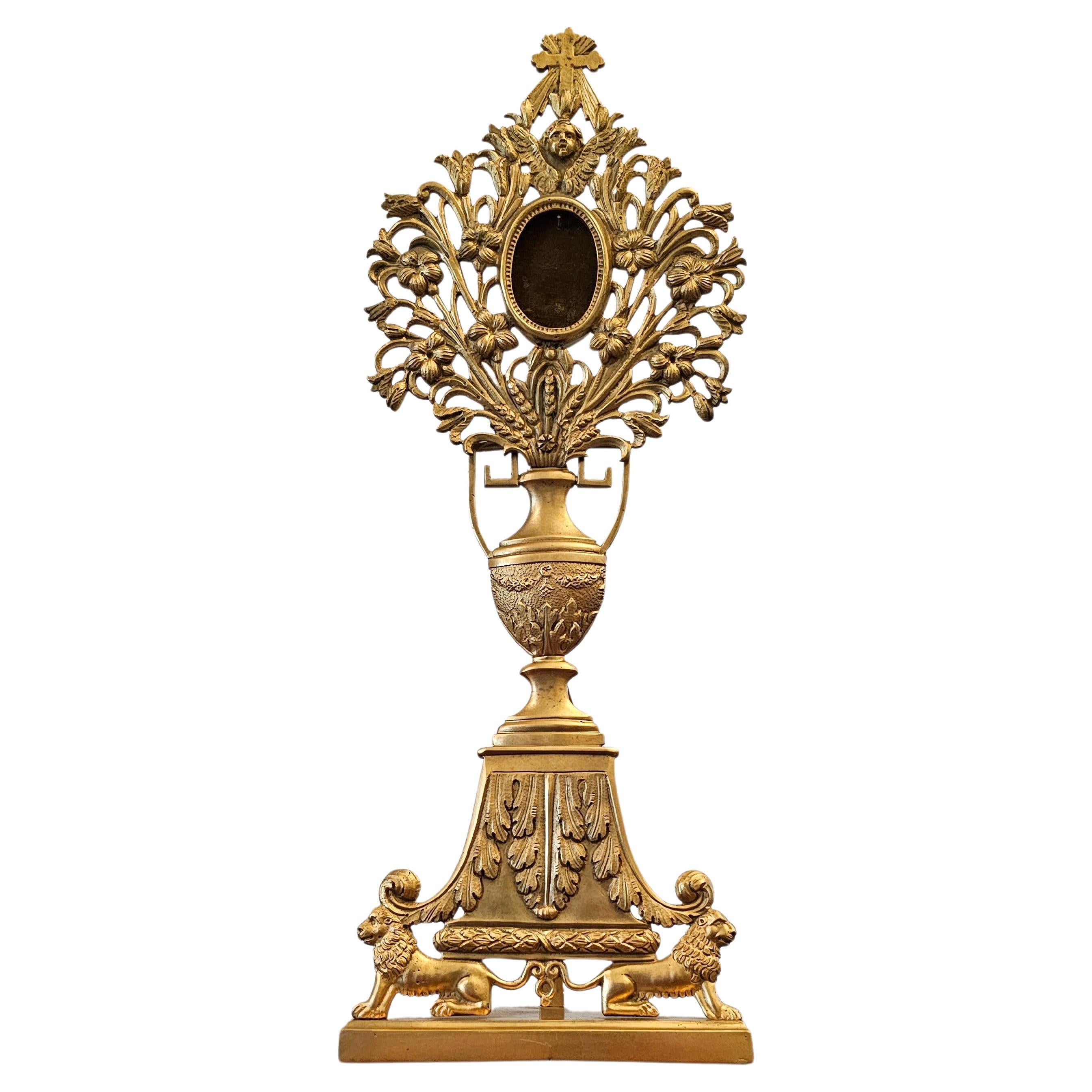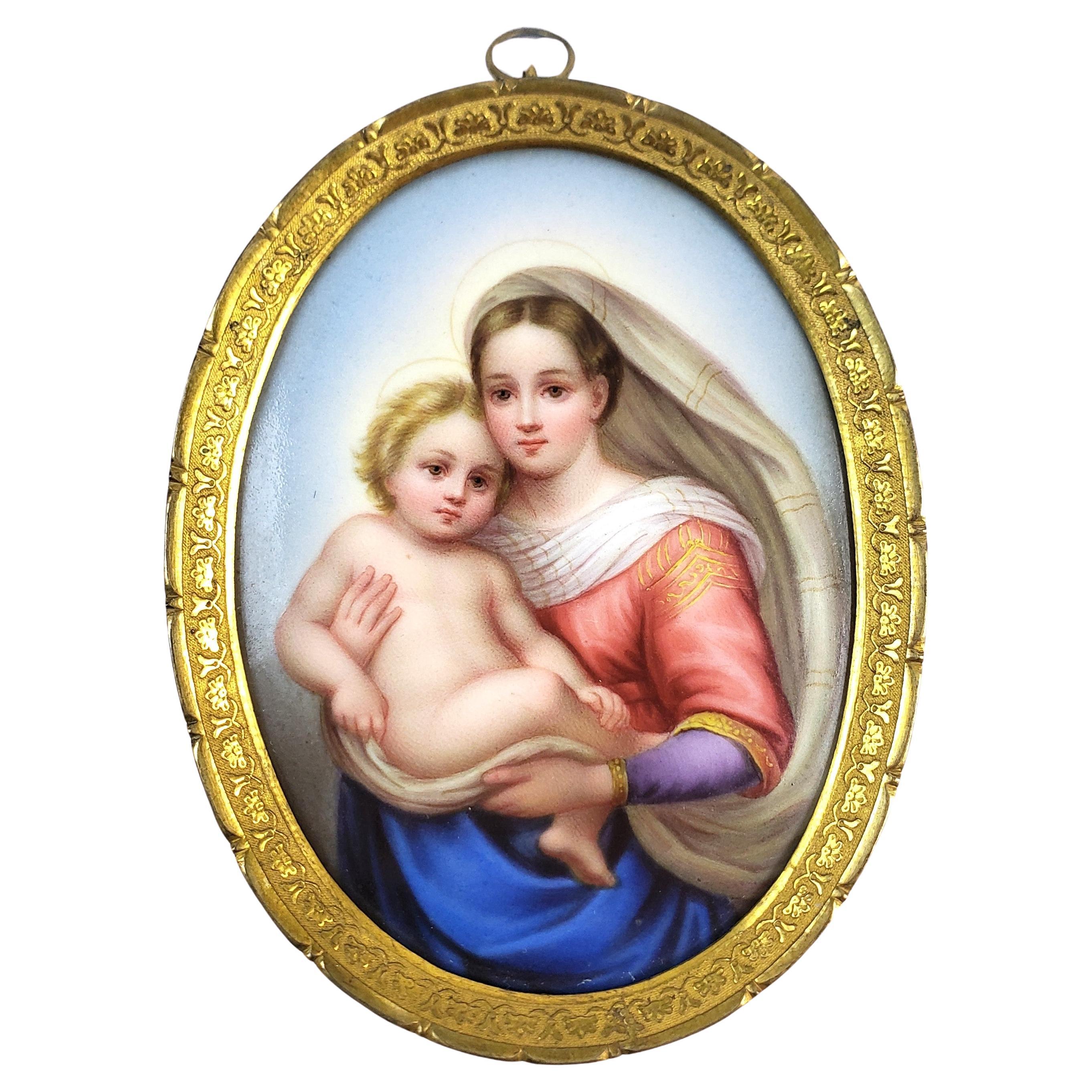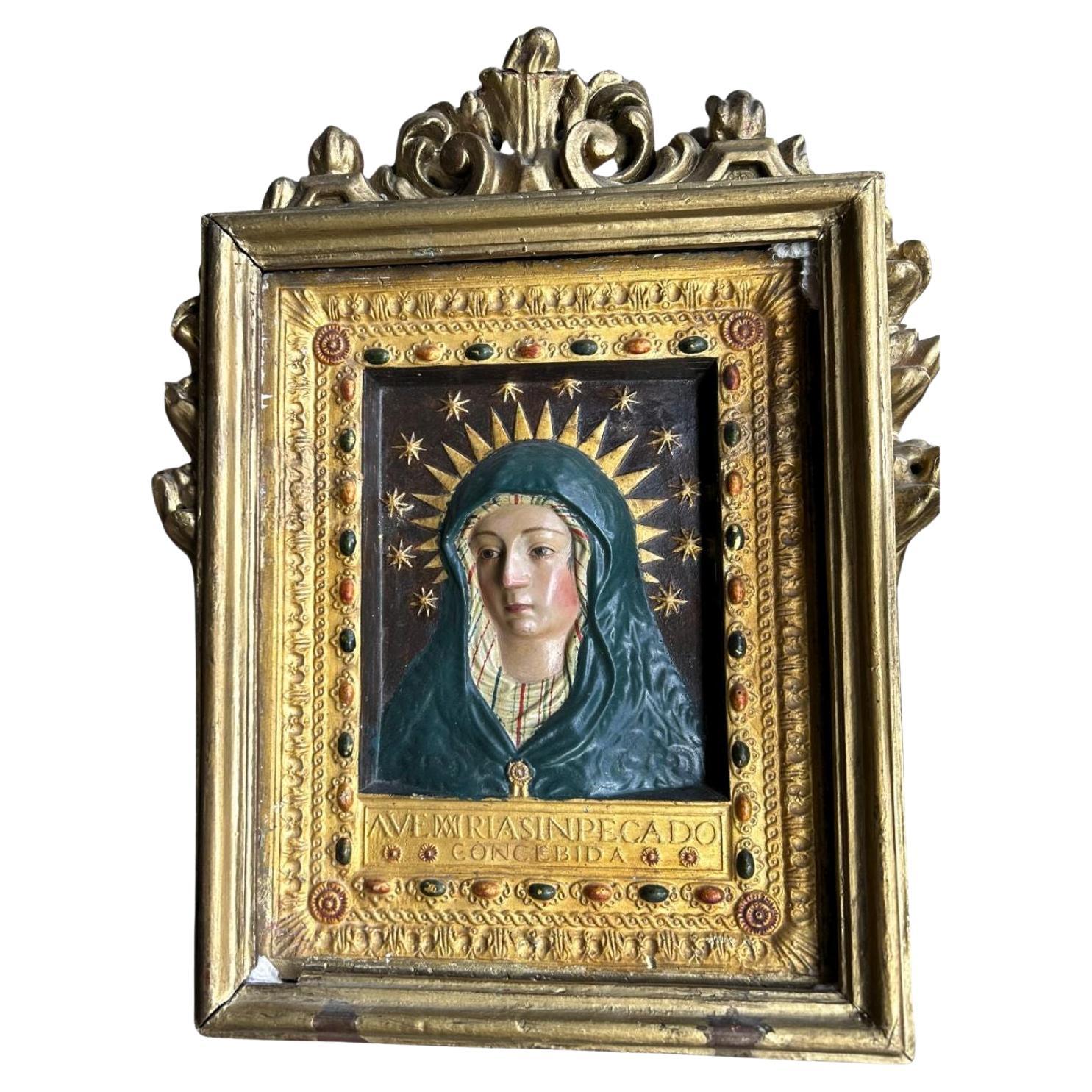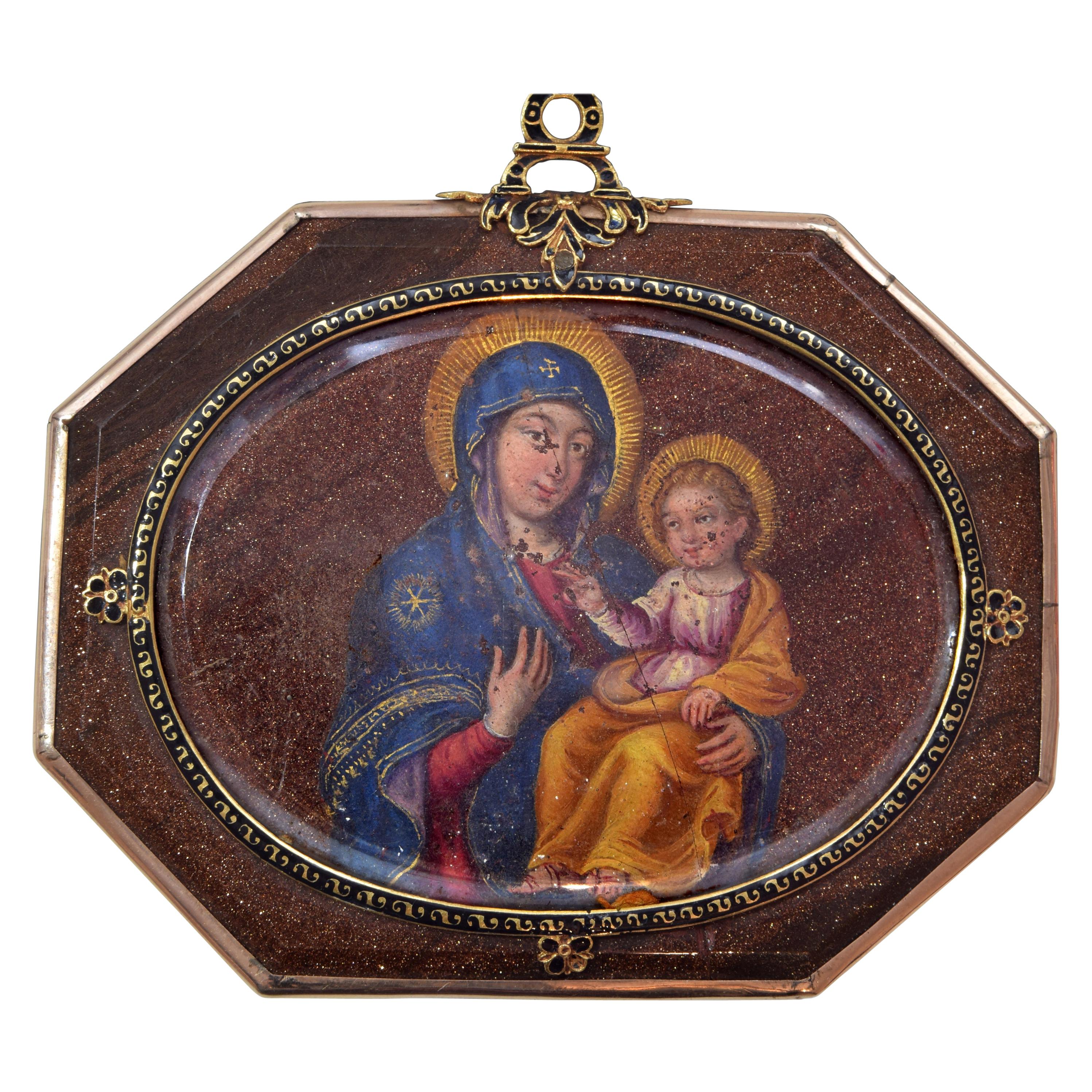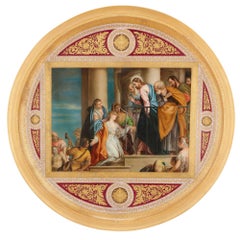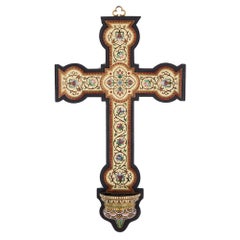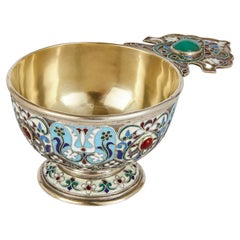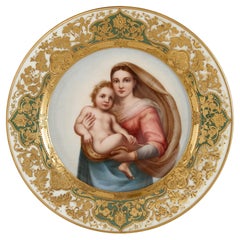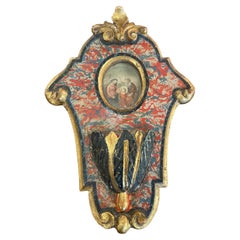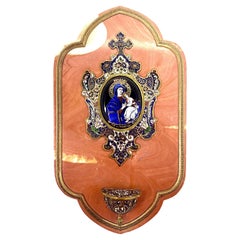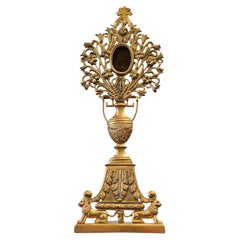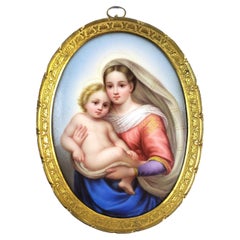Items Similar to Very Fine Gilt Bronze, Cloisonné Enamel and Porcelain Holy Water Stoup
Want more images or videos?
Request additional images or videos from the seller
1 of 8
Very Fine Gilt Bronze, Cloisonné Enamel and Porcelain Holy Water Stoup
$20,552.50
£15,000
€17,496.69
CA$28,151.79
A$31,310.93
CHF 16,349.60
MX$381,020.73
NOK 208,809.28
SEK 195,826.27
DKK 130,584.52
Shipping
Retrieving quote...The 1stDibs Promise:
Authenticity Guarantee,
Money-Back Guarantee,
24-Hour Cancellation
About the Item
A very fine gilt bronze, cloisonné enamel and porcelain holy water stoup
French, late 19th century
Measures: Height 54cm, width 34cm, depth 9cm
This beautiful piece is an ormolu, cloisonné enamel and porcelain stoup, a specific type of vessel for holy water often found inside the entrances to Catholic churches. Made in France in the late nineteenth century, it features in the centre an oval-shaped porcelain plaque that takes for its subject the 'Madonna della Seggiola' by Italian Renaissance master Raphael.
The image of the Virgin mother and child in the centre is after one of Raphael's most beloved and well-known paintings, currently housed in the Palazzo Pitti, Florence. The image is set in a gilt bronze frame with beautiful cloisonné enamel decoration, and the stoup is topped with a cross and two angels holding the 'arma Christi'. At the base of the piece is a tridacna, a clam shaped pendant, which is framed with reeds and supported by putti above a phylactery engraved 'Ave Maria'.
- Dimensions:Height: 54 in (137.16 cm)Width: 34 in (86.36 cm)Depth: 9 in (22.86 cm)
- Style:Renaissance (In the Style Of)
- Materials and Techniques:
- Place of Origin:
- Period:
- Date of Manufacture:Late 19th Century
- Condition:Wear consistent with age and use.
- Seller Location:London, GB
- Reference Number:Seller: 172461stDibs: LU956333424452
About the Seller
5.0
Recognized Seller
These prestigious sellers are industry leaders and represent the highest echelon for item quality and design.
Established in 1975
1stDibs seller since 2012
412 sales on 1stDibs
Typical response time: 4 hours
Associations
The British Antique Dealers' AssociationInternational Confederation of Art and Antique Dealers' Associations
- ShippingRetrieving quote...Shipping from: London, United Kingdom
- Return Policy
Authenticity Guarantee
In the unlikely event there’s an issue with an item’s authenticity, contact us within 1 year for a full refund. DetailsMoney-Back Guarantee
If your item is not as described, is damaged in transit, or does not arrive, contact us within 7 days for a full refund. Details24-Hour Cancellation
You have a 24-hour grace period in which to reconsider your purchase, with no questions asked.Vetted Professional Sellers
Our world-class sellers must adhere to strict standards for service and quality, maintaining the integrity of our listings.Price-Match Guarantee
If you find that a seller listed the same item for a lower price elsewhere, we’ll match it.Trusted Global Delivery
Our best-in-class carrier network provides specialized shipping options worldwide, including custom delivery.More From This Seller
View AllRenaissance Style Gilt Bronze and Porcelain Plaque by Royal Vienna
By Royal Vienna Porcelain, Paolo Veronese
Located in London, GB
This fantastic porcelain plaque features some exceptionally splendid gilded decoration, but it is the central Biblical scene which makes it a truly special piece. Depicting the story...
Category
Antique Late 19th Century Austrian Renaissance Decorative Art
Materials
Ormolu, Bronze
Antique Large Cloisonné Enamel Wall Crucifix with Font
Located in London, GB
Antique large cloisonné enamel wall crucifix with font
French, Late 19th Century
Height 57cm, width 33cm, depth 7cm
This superb decorative cross is designed to hang on a wall, enabled by the small clover-shaped gilt metal handle which surmounts the top. The cross is shaped as a traditional Christian budded crucifix, and features stunning cloisonné enamel decoration that is expertly contrasted by an ebonised wood backing.
The cross is centred by a budded panel, that features four blooming flowers wrapped within their vines in a heart-esque pattern. These designs are bordered by a red and gilt geometric surround, which provides an interesting contrast to the more flowing linearity within. Similar flower-and-vine motifs, as well as similar geometric bordering, adorn the rest of the cross’s main body. The colour contrasts within the cloisonné enamel are particularly pleasing, with the pale-yellow ground making the bright hues of the foliate decoration stand out.
At the bottom of the cross sits a font, or stoup, originally designed to hold holy water. The font is also decorated with cloisonné enamel, but employs a geometric layered design in differing shades.
The reverse of the cross is stamped ‘1138’.
Replete with refined decorative elements, this excellent piece of religious décor...
Category
Antique Late 19th Century French Religious Items
Materials
Enamel
Silver Gilt Bejewelled Cloisonné Enamel Russian Charka
Located in London, GB
Silver gilt bejewelled cloisonné enamel Russian charka
Russian, 20th Century
Height 5cm, width 12cm, depth 7cm
Made in Russia in the 20th century, this antique charka drinking ves...
Category
20th Century Russian Belle Époque Decorative Bowls
Materials
Silver, Enamel
Antique Dresden porcelain cabinet plate depicting the Madonna after Raphael
By (after) Raphael (Raffaello Sanzio da Urbino), Dresden Porcelain
Located in London, GB
Antique Dresden porcelain cabinet plate depicting the Madonna after Raphael
German, c. 1880
Height 2.5cm, diameter 19.5cm
This finely painte...
Category
Antique Late 19th Century German Renaissance Porcelain
Materials
Porcelain
Pair of French Gilt and Silvered Bronze Candelabra, Depicting Jesus and Madonna
Located in London, GB
These striking and unusual candelabra each depict a portrait of Jesus and the Madonna in gilt bronze to the center. Each portrait is bordered by a gilt geometric circular pattern, further surrounded by a circular wreath of acanthus leaf in silvered bronze, supporting eight lights and drip pans. The candelabra are supported on ornately cast columns...
Category
Antique 19th Century French Baroque Candelabras
Materials
Bronze
Ormolu and Cloisonné Enamel Jardinière Attributed to F. Barbedienne
By F. Barbedienne Foundry
Located in London, GB
The large central circular form cloisonne enamel jardinière decorated with vari colored plum flowers and butterflies on a blue ground, with a pierced ormolu rim featuring a pineapple motif resting on a finely cast ormolu base with four legs in the form of winged Foo lions.
The ormolu French, the enamel Chinese.
This impressive jardinie`re is very much in the manner of objects in enamel produced by Ferdinand Barbedienne in Paris in the last quarter of the 19th century which proved universally popular. Often these pieces were designed by Edouard Lievre (d. 1886) in the Oriental taste.
Ferdinand Barbedienne was a famous French metal worker and manufacturer. He presided over one of the most renowned and prolific foundries of Belle Époque Paris. His atelier created sculptures, clocks and bronze mounts of the highest quality, and his works were shown at numerous international exhibitions of the period, where he was rewarded with many medals. Among them the Grande Me´daille d'Honneur, in Paris in 1855 is particularly noteworthy.
In 1838 he associated with the engineer Achille Collas (1795-1859) who had just invented a process to reproduce statues at a smaller scale.
Together they founded in 1839 the company "Collas et Barbedienne" to reproduce casts of both contemporary artists and Greek and Roman antiquities. While working with Collas, Barbedienne actively pursued contracts with many sculptors of Paris contracting with David D'Angers, Jean-Baptiste Clesinger, and even producing some casts for Antoine Louis Barye as well as others. From 1860 to the years 1890, Barbedienne, eager to research new processes, experimented new techniques in champleve´ and cloisonne´-enamels, to compete with Japanese importations, very fashionable then.
When Collas died in 1859, the business was left to Barbedienne as sole owner. The company who had over 300 employees was prosperous as well in the field of reproductions as in its department specialized in the casting of monumental bronzes.
In 1865, he was appointed President of the Reunion of Bronze Makers until 1885.
After the 1870 war...
Category
Antique Late 19th Century French Chinoiserie Planters, Cachepots and Jar...
Materials
Enamel, Ormolu
You May Also Like
18th Century Italian Hand-Carved Polychrome GIlt Holy Water Font
Located in Milano, MI
From Italy, Marche central region, a polychrome carved holy water font mid-18th century, a shaped panel with carved and gilt scrolls and acanthus leaf details. A green edge decoratio...
Category
Antique Mid-18th Century Italian Rococo Decorative Art
Materials
Poplar
Antique French Gold Bronze, Enamel & Rouge Marble "Benetier" Holy Water Font.
Located in New Orleans, LA
Rare Antique French Gold Bronze, Enamel & Rouge Marble "Benetier" Holy Water Font.
Exquisite French Workmanship
Category
Antique 19th Century French Religious Items
Materials
Marble, Bronze, Enamel
Fine 19th Century European Gilt Bronze Ormolu Monstrance Reliquary
Located in Forney, TX
A scarce fine quality neoclassical Empire style vasiform gilt bronze ormolu church religious relic altar monstrance reliquary.
Exquisitely hand-crafted in Continental Europe in the second half of the 19th century, most likely French Napoleon III Period (1852-1870), having a fanned cross crest, above winged angel mask, central oval display...
Category
Antique 19th Century European Empire Sculptures and Carvings
Materials
Bronze, Ormolu
Madonna Della Sedia Antique Framed Hand-Painted Portrait on Porcelain
Located in Hamilton, Ontario
This finely executed portrait is unsigned and presumed to have originated from Italy and date to approximately 1900 and done in a Renaissance style. The portrait is hand-painted on a...
Category
Early 20th Century Italian Renaissance Religious Items
Materials
Metal
Relieve Virgen Maria. Carved and Gilded Frame in the Baroque Style
Located in Mexico City, MX
Polychromed and Gilded Plaster
Carved and Gilded Frame in the Baroque Style
Hispanic World 18th-19th Century
This beautiful bust figure of the Virgin Mary is carved in relief on liv...
Category
Antique Late 18th Century Mexican Baroque Religious Items
Materials
Plaster
Devotional Pendant, Oil on Aventurine, Gold, Enamel, Spain, 17th Century
Located in Madrid, ES
Devotional pendant or reliquary. Oil painting on aventurine, enamel, gold. Spain, 17th century.
Medallion or devotional pendant or reliquary made of aventurine or aventurine with an octagonal shape and faceted fronts, enhanced with a series of enamels combining black and gold, which protect two oil paintings with a Catholic Christian religious theme, located one on each side of the piece. Protected, you can see a very particular Virgin with Child for being inspired by the Icon of the Madonna del Popolo (Rome, Italy), and a simplified Martyrdom of San Lorenzo (the saint, the grill and an angel with a crown and the palm corresponding to the subject). The edges of the piece have been protected with simple metal elements.
The painting of San Lorenzo follows a common composition in the Spanish school, and would recall works such as the painting of the main altar of the Church of San Lorenzo de Huesca, for example, but also others such as the engraving by Marcantonio Raimondi (executed around 1527) in some details. The so-called icon of the Madonna del Popolo was well known for being considered as made by Saint Luke, and was brought to the church of the same denomination by Gregory IX from the Sancta Sanctorum of the Lateran Palace after a flood caused a terrible plague in the city and through a solemn procession with the image of Santa Maria del Popolo.
Regarding the material of the piece, a certain type of glass and a type of quartz (which can be green or reddish-brown, and usually has tiny elements of yellow mica that give it golden reflections) is known as aventurine or aventurine. In the first case, it is known that “aventurine” or “stellaria” appears mentioned in the Murano workshops for the first time during the first quarter of the 17th century, in reference to a very complicated production paste (it is said that the name comes from of this circumstance, that is, that its creation was due to luck or luck) that imitates the effects of that stone (from India and Russia at that time) thanks to the inclusion of copper particles, and that it was used as if out of stone (cut) given the complexity of its use in blowing (practically impossible). And, dealing with this material, it is necessary to mention “The Nativity” by Pietro da Cortona, dated around 1656, which is kept in the El Prado...
Category
Antique 17th Century Spanish Baroque Religious Items
Materials
Gold, Enamel, Other
More Ways To Browse
Water Gilt Frame
Renaissance Plaque
Florence Porcelain
Antique Religious Pendants
French Enamel Religious
Angel Porcelain
Enamel Angel
Antique Holy Water
Putti Plaque
Oval Porcelain Plaque
Gilt Bronze Angel
Antique Catholic Crosses
Used Catholic Church Items
Antique Catholic Church Items
Enamel Plaque Painting
Bronze Religious Plaque
Angel Plaques
Ave Maria
